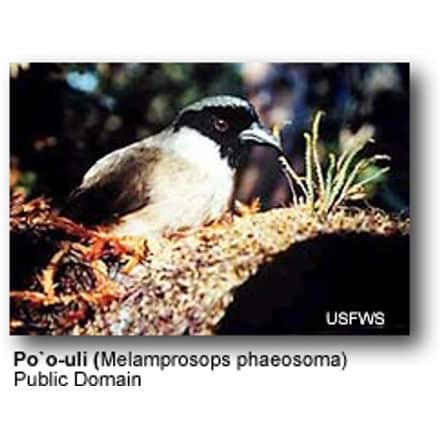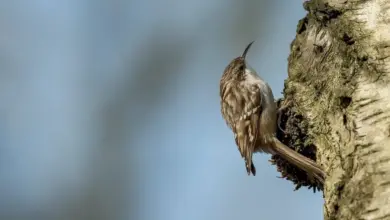Po’o-uli or Black-faced Honeycreepers
Hawaiian Honeycreepers

Discovery, Taxonomy, and Behavior
The Po’ouli was not discovered until 1973 by students from the University of Hawai’i, who found the bird on the north-eastern slopes of Haleakala on the island of Maui. It was found during the Hana Rainforest Project at an altitude of 1,980 metres (6,500 ft) above sea level. The Po’ouli was the first species of Hawaiian Honeycreeper to be discovered since 1923. It is dissimilar to other Hawaiian birds. Evidence based on DNA suggests it belongs to an ancient lineage of honeycreepers. It appears to have out-lived all its close relatives; that is if it had any close relatives. No other bird – living or fossil – has a structure similar to it.
It feeds mostly on snails, insects, and spiders and nests in native ‘ōhi‘a lehua (Metrosideros polymorpha) forests.
Status
In the past, according to fossil records, it seems that the bird lived on the dry half of the island of Maui, across southwestern slope of Halekala at altitudes of 275–1,350 metres (900–4,430 ft). 200 Po’ouli were estimated to exist when the species was first discovered. There were only 76 birds per km². By 1981, there were only 15 birds per km². By 1985, there were only 8 per km². That meant that from the year 1975, when it was first discovered, to 1985, only ten years later, the population had dropped by over 90 percent. Sometime during the 1980s, the Po’ouli disappeared from the easternmost part of its range and was now only found in the western branch of the Hanawi Stream.
To preserve the Po’o-uli or Black-faced Honeycreeper and other endangered fauna and flora, the State of Hawaii established the 9,500-acre (38 km2) Hanawi Natural Area Reserve. This connected several protected areas to make one larger protective area. This protection effort was only possible due to the work of several groups: the government, Maui County, the National Park Service, The Nature Conservancy, and several private companies. The land was fenced off and by June 1996 they began to clear out the pigs from the closed areas. Four years and 202 pigs later, the Po’ouli pen was completely cleared of pigs. As more pigs were removed from the other two pens, population of native species that lived there, e.g. the Maui Parrotbill and ‘Akohekohe, rose slightly faster than they otherwise would have. Rats, cats, and goats were still being removed from the Po’ouli pen.
By 1997, only three individuals were known to exist. These had home ranges within the Hanawi Natural Area Reserve and the adjacent Haleakala National Park.
In 2002, one of these, a female, was captured and taken to a male’s home range in an attempt to get them to breed. The female, however, had flown back to her own territory, which was 1.5 miles (2.4 km) away, by the next day. There was also a ten-day expedition in 2004. The goal of this was to capture all three birds and bring them to a bird conservation center on the island, in the hope they would produce offspring.
On September 9 2004, one the remaining birds, a male, was captured and taken to the Maui Bird Conservation Center in Olinda, in an attempt to captively breed the bird. However, biologists could not find a mate for the male before it died on November 26 2004.
Tissue samples have been taken from the male for possible future cloning, but as neither birds of the opposite sex are now available nor natural behavior can be imprinted on possible cloned individuals, this does not seem probable. As such efforts would likely compete with conservation funding of extant bird species, it may not even be desirable as a cloning attempt would both be highly likely to fail and at the same time jeopardize the survival of other highly threatened species. If the two remaining birds still survive, they are at least ten years of age, nearing the end of their life, and probably have not been fertile for a few years. It is uncertain whether they are a male and female, or both are of the same sex. Since 2004, extensive surveys have failed to locate these or other individuals of this species and it could be extinct, but remains listed as Critically Endangered by BirdLife International (and thereby IUCN) until additional surveys have confirmed its extinction beyond reasonable doubt.
The dramatic population decline has been attributed to a number of factors, including habitat loss, mosquito-borne diseases, predation by pigs, rats, cats, and Small Asian Mongooses, and a decline in the native tree snails that the Po’ouli relies on for food.
Copyright: Wikipedia. This article is licensed under the GNU Free Documentation License. It uses material from Wikipedia.org … Additional information and photos added by Avianweb.
Please Note: The articles or images on this page are the sole property of the authors or photographers. Please contact them directly with respect to any copyright or licensing questions. Thank you.

